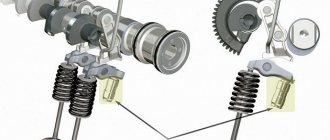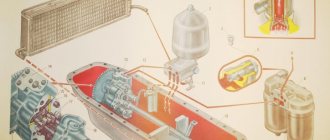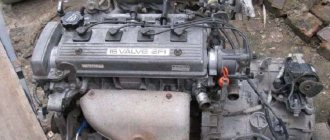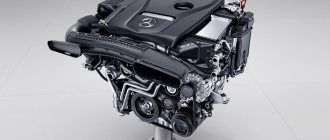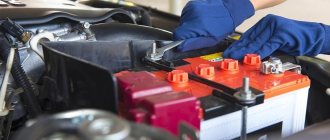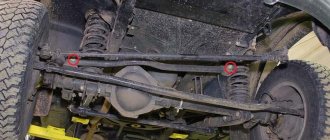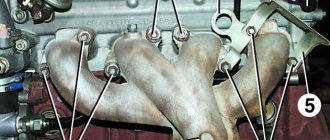Why are hydraulic compensators knocking?
What does a hydraulic compensator look like?
Of course, the inclusion of hydraulic compensators in the engine design increased its reliability, stability of operation, and the operation of the engine itself became softer and smoother. However, problems arise with these devices. A characteristic sign of problems with hydraulic compensators is their knocking. Well, only then problems characteristic of unregulated valves appear. What is the weak point of the hydraulic compensator?
The knocking sound of the hydraulic compensator indicates that for some reason the device does not have time to select the required valve clearance. In other words, the compensator has partially or completely ceased to perform its functions. There can be four reasons for such sabotage:
- low pressure in the lubrication system;
- wear of the plunger pair;
- worn or clogged ball valve;
- device jamming;
If the cause of the failure of the hydraulic compensator is wear in the plunger pair or the ball valve has exhausted its service life, the device will have to be replaced. If the valve is simply clogged due to low quality oil, you can try to flush it. Well, as for low oil pressure in the system, this is not a problem with the hydraulic compensator at all. Accordingly, it is not necessary to eliminate it here. If the device is jammed, most likely the hydraulic compensator will also have to be changed.
Main faults, possible causes and replacement
A knocking sound indicates a malfunction in the gas distribution mechanism. If there are hydraulic compensators, then the reason may be in them:
- Malfunction of the hydraulic pushers themselves: failure of the plunger pair or jamming of the plungers, jamming of the ball valve, natural wear.
- Low oil pressure in the system.
- Clogged oil channels in the cylinder head;
- Air entering the lubrication system.
It can be quite difficult for an ordinary car enthusiast to identify a faulty gap compensator. To do this, for example, you can use a car stethoscope. It is enough to listen to each hydraulic compensator to determine the faulty one by its characteristic knocking sound.
You can also check the functionality of the hydraulic compensators if you can remove them from the engine. When filled, they should not shrink. Some types can be disassembled and the degree of wear of internal parts can be determined.
Poor quality oil leads to clogging of oil channels. This can be corrected by replacing the oil itself, the oil filter and washing the hydraulic compensators. You can wash it with special liquids, acetone or high-octane gasoline. If it's the oil, this should help eliminate the knocking noise.
Experts recommend replacing not individual compensators, but all at once. This should be done after 150-200 thousand kilometers. At such a distance they are subject to natural wear and tear.
When replacing hydraulic lash compensators, you need to observe some nuances:
- New hydraulic pushers are already filled with an oil composition. There is no need to remove this oil. The oil is mixed in the lubrication system and air will not enter the system.
- You cannot install “empty” expansion joints (without oil) after washing or disassembling. This is how air enters the system.
- After installing new hydraulic compensators, it is recommended to turn the crankshaft several times. This is done so that the plunger pairs come into working condition and the pressure increases.
- After replacing the hydraulic tappets, it is recommended to change the oil and filter.
To ensure that hydraulic compensators cause as few problems as possible during operation, you need to use high-quality motor oil, which is recommended in the car’s operating manual. It is also necessary to follow the rules for changing the oil and filter. By following these rules, hydraulic compensators will last a long time.
Source
Hydraulic compensator for a car - simple about complex things!
In order to understand the principle of operation of the hydraulic compensator, and therefore determine why it fails and how to repair it, you need to remember the design of the engine. Do you remember how the valves are located and what they are for? The intake valve is responsible for the supply of fuel, and the exhaust valve is responsible for the exit of gases exhausted during fuel combustion in the engine.
So, a hydraulic compensator is a device that regulates the valve clearance automatically, thus ensuring a uniform supply of fuel to the working chamber of the engine and the exhaust outlet. Installing hydraulic compensators eliminates the process of manually adjusting the valves for the manufacturer's servicemen, which, by the way, is very labor-intensive and time-consuming.
We recommend: I washed the engine, why the car won’t start
Increased and decreased clearance: consequences
Insufficient intake valve clearance (valves are clamped) does not allow complete closure. Tightened intake valves in a gasoline engine will cause the air-fuel mixture to partially burn in the intake. In this case, starting the engine is complicated, the unit does not develop power, consumes a lot of fuel, etc.
For exhaust valves, the consequences of improper adjustment are much more serious. Hot gases from the combustion chamber will rush through leaks, causing the valve disc to burn out and destroy the valve seat. Insufficient valve fit in a diesel engine can lead to a significant drop in compression, which will not allow the diesel engine to continue to operate normally.
A large gap causes strong shock loads, as a result of which a sharp and frequent metallic knock will be heard in the valve cover area, which increases with increasing speed. In this case, wear of the valve mechanism, camshaft and other timing elements accelerates. If the valves do not open completely, then the flow area is reduced. This means that the cylinders are less well filled with the fuel mixture (air in a diesel engine) and are poorly ventilated. At the same time, engine power is greatly reduced, and the content of harmful substances in the exhaust gases increases.
We also recommend reading the article about why a gasoline engine can sound similar to a diesel engine. From this article you will learn about the causes and possible malfunctions of the power unit.
It is quite obvious that not only the most important performance indicators of the power unit, but also its overall engine life will depend on correctly adjusted valves. Manual adjustment of the thermal clearance of valves is a planned procedure, is carried out using a feeler gauge, shims and levers, and also requires certain skills. This adjustment is carried out every 10-15 thousand kilometers. An additional complication of manual adjustment is that in order to achieve “soft” operation of the timing valve, it is necessary to adjust it taking into account various temperature fluctuations, and not according to the average value. Many car repair shops don't do this.
Taking into account these difficulties, so-called hydraulic compensators began to be used in the timing belt design, which automatically select the required gap.
Thanks to this solution, the need to manually adjust the valves is completely eliminated. Hydraulic valve thermal clearance compensators are a timing part that is capable of independently changing its length by an amount equal to the thermal clearance.
How do hydraulic compensators work in an engine?
Hydraulic pusher operating diagram
The hydraulic compensator device is quite simple, but this part performs an important function.
The hydraulic compensator is an oil-filled cylinder with a retractable piston. This cylinder is filled with oil under pressure. There is also a spring and a ball that blocks the drainage hole and prevents the oil from escaping, thereby creating some elasticity. This is the principle of operation of hydraulic valve compensators. Due to the low oil compression ratio, these parts act as a kind of rigid element between the camshaft and the valve. The camshaft cam presses on the hydraulic tappet, which, in turn, opens the valve. The hydraulic compensator device is quite simple, but this part performs an important function.
Hydraulic compensators - design secrets
Let's get a little technical and look at how these devices automatically maintain the same clearance. Its main structural elements are:
- frame;
- plunger pair;
- plunger spring;
- check valve
The meaning of the operation of hydraulic valve compensators is to automatically compensate for gaps in the engine gas distribution mechanism that change under the influence of various factors, which is achieved by changing their length using springs and oil pressure.
As we mentioned above, hydraulic compensators are located between the camshaft (its cams) and the valves.
When the shaft cam is turned with its back side, a portion of oil enters the compensator from the ramp, which fills its cavity, and it seems to move up and down until it compensates for the gap between its body and the surrounding elements of the timing system.
When the shaft cam turns with its convex side towards the hydraulic compensator and presses on it, our today's hero is locked, and the oil, due to its incompressibility, turns it into a rigid element that presses on the valve, opening it.
When the compensator moves, part of the oil from its plunger pair exits through the existing internal gaps, and when returning to its original position, a fresh portion enters the hydraulic compensator from the ramp, filling its insides, and again the gaps are compensated.
We recommend: Wheel alignment adjustment: is it difficult to do it yourself?
What are hydraulic compensators
Hydraulic compensators replaced the standard adjusting bolts. The essence of their action is that they automatically set the gap depending on the engine temperature. The use of these devices has been very justified, because along with them the following advantages have appeared:
- The motor is quieter . It is worth noting that automatic selection of gaps allows you to achieve the quietest engine operation, which is very important when driving for a long time on the highway.
- The dynamics of the car increases noticeably . After all, when the combustion chamber is properly closed, the best compression is achieved, which undoubtedly affects the behavior of the car. Moreover, this feature can be noticed in any engine operating mode.
- Fuel economy . If the chamber is hermetically sealed, then inefficient combustion of fuel is eliminated. This approach allows you to save gasoline and get the most out of your engine.
- Increased timing belt service life . Since the gaps are always set correctly, this contributes to longer operation of the mechanism.
However, this system also has a number of disadvantages:
- Repairing hydraulic compensators is relatively expensive, as are the parts themselves.
- If low-quality oil is used, the devices will not be able to fully ensure proper operation. This is due to the fact that their operation is based on the use of motor oil.
Consequences of inaction when hydraulic compensators knock
If the knocking is actually caused by hydraulic compensators, untimely replacement or repair of hydraulic compensators will lead to a reduction in the service life of the gas distribution mechanism drive and the cylinder head.
Repairing both the first and second nodes is an expensive and burdensome pleasure.
And finally, let’s say that you can, of course, both diagnose the problem on your own and also fix it yourself.
But flushing or replacing hydraulic compensators is a direct intervention in the power unit systems of your car, so if you feel the slightest doubt in your abilities, take the trouble to contact an authorized service center.
If you “mess up”, you will still need to contact the “officials”, and they will definitely determine that someone has already looked under the valve cover before them, because even checking the hydraulic compensators requires opening the valve cover and turning the crankshaft manually.
In the worst case scenario, you will not only pay for expensive repairs to the power unit or timing drive, but will also be excluded from warranty service (if your car is still covered by the warranty).
Any risk must be justified, and replacing hydraulic compensators is not a problem that can be solved in the middle of a highway in the complete absence of spare parts and necessary tools. Think 10 times whether it is worth taking on such work yourself, or whether it is better to entrust it to professionals.
Timely identification of the problem and simple operations to eliminate it, even if you contact a service center, are the key to saving your money and the resource of the machine’s power unit.
Design and principle of operation of hydraulic compensators
The device of a standard hydraulic compensator is represented by a housing with a movable plunger pair inside, which includes a spring-loaded plunger with a ball valve and a bushing. The housing can be a part of the cylinder head, a cylindrical pusher, or elements of valve drive levers.
The operation of the hydraulic compensator largely depends on the plunger pair. Thanks to a gap of 5 - 8 microns between the plunger and the bushing, on one side the connection is completely sealed, and on the other side the parts move freely relative to each other.
A check ball valve closes the hole in the bottom of the plunger, and a spring of the required stiffness is installed between the plunger and the bushing.
The operating principle of hydraulic valve compensators is discussed in more detail below:
- The thermal gap remains between the camshaft and the housing at the moment when the camshaft cam is positioned with its back side towards the pusher.
- Through the oil channel, oil enters the plunger from the lubrication system, and at the same time a spring acts on the plunger and lifts it, compensating for the gap. Oil also enters the cavity under the plunger.
- As the shaft turns, pressure is exerted on the follower from the cam side, causing it to move downward.
- The check ball valve closes, and the plunger pair takes on the role of a rigid element, transmitting force to the valve.
- A little oil is squeezed out from under the plunger because there is a gap between it and the bushing, but since the oil comes from the lubrication system, the leakage is compensated.
- The length of the hydraulic compensator changes slightly because the parts heat up when the engine is running, but the gap is automatically compensated by changing the volume of the oil portion.
We recommend: Engine compression and compression ratio

